Earlier this year, the San Francisco Public Press featured Gregory Nelson in “Driving Home: Surviving the Housing Crisis,” a photojournalism project by Yesica Prado documenting the experiences of people living in vehicles in the Bay Area. Prado followed up with Nelson to find out how his life has changed during the pandemic.
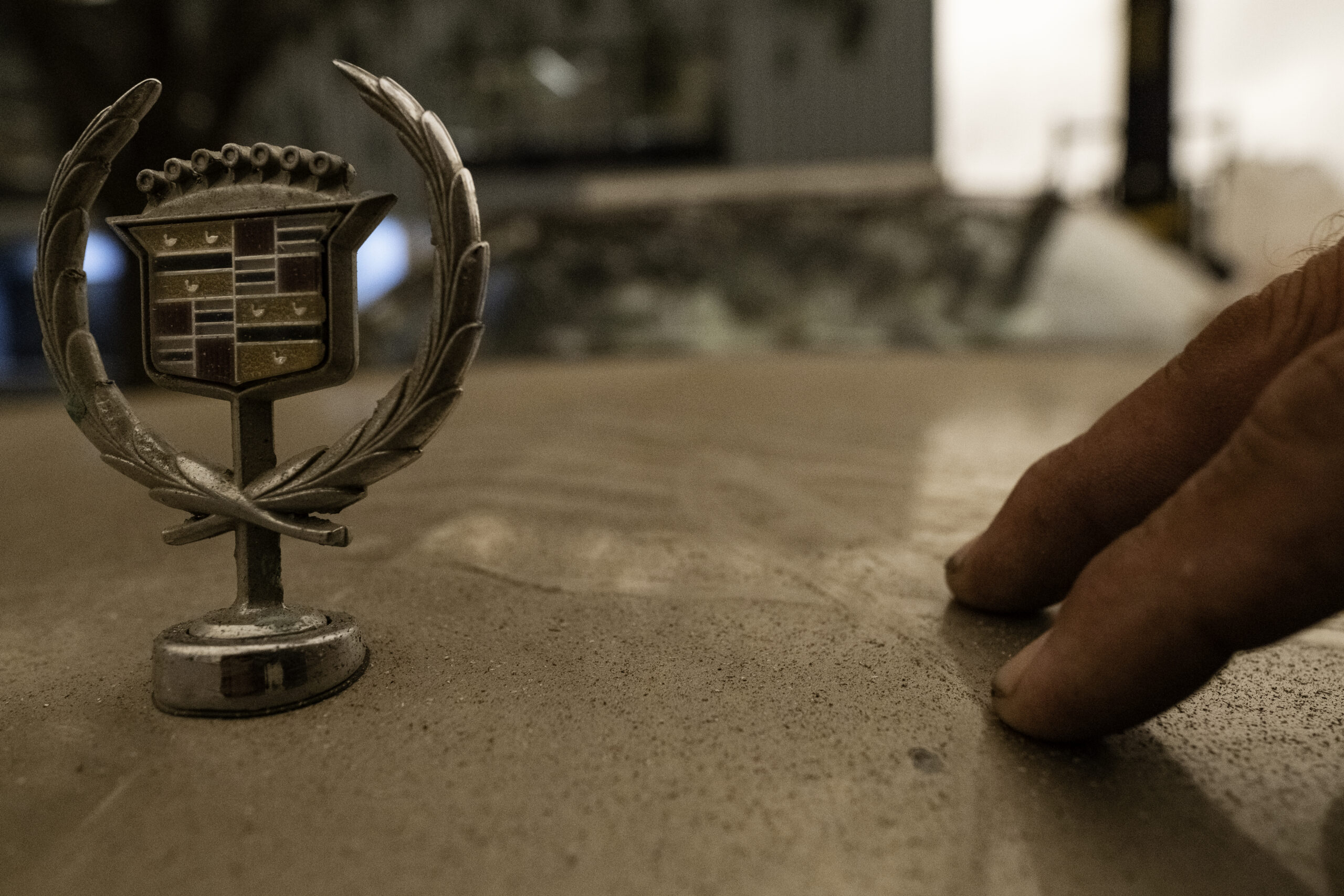

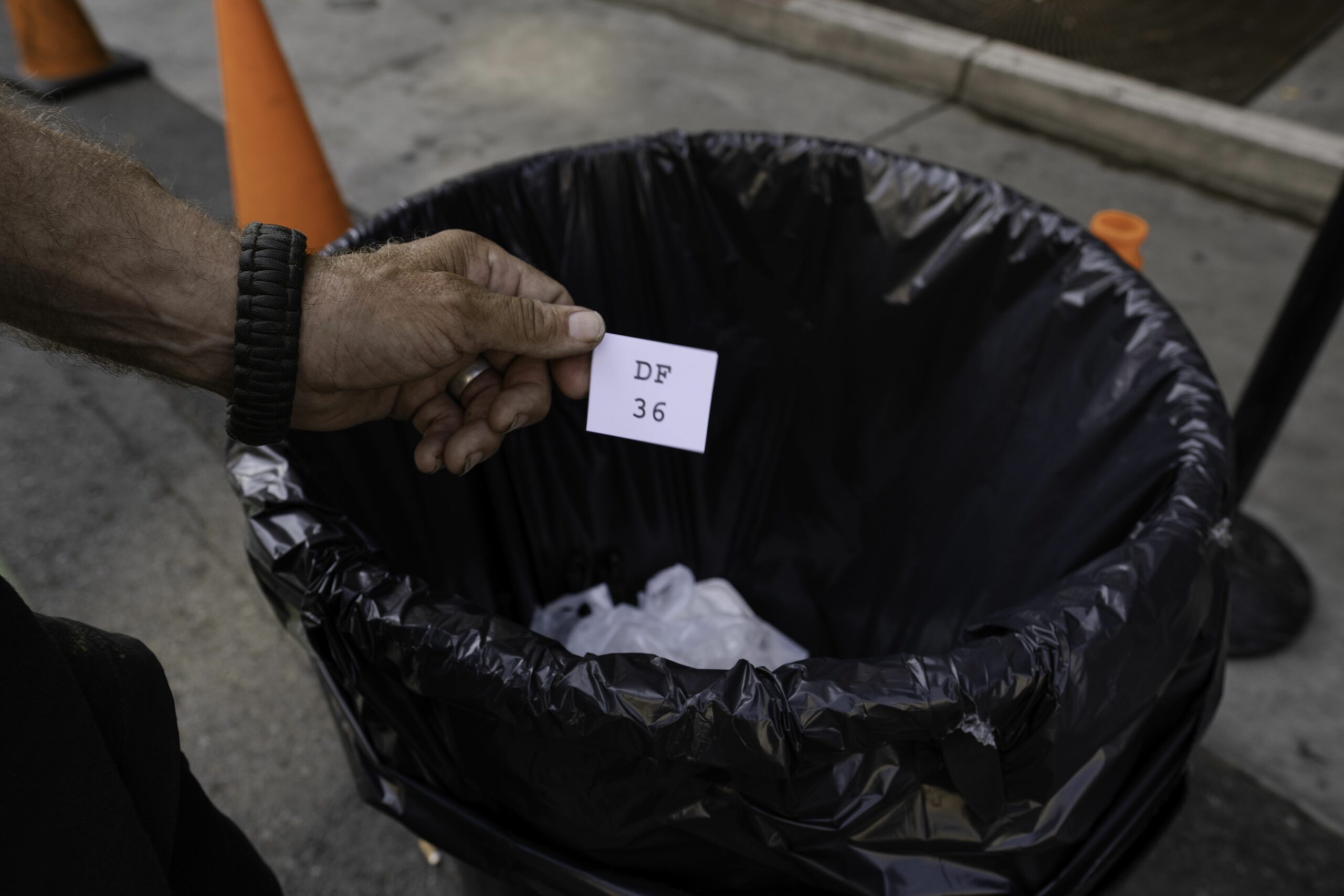
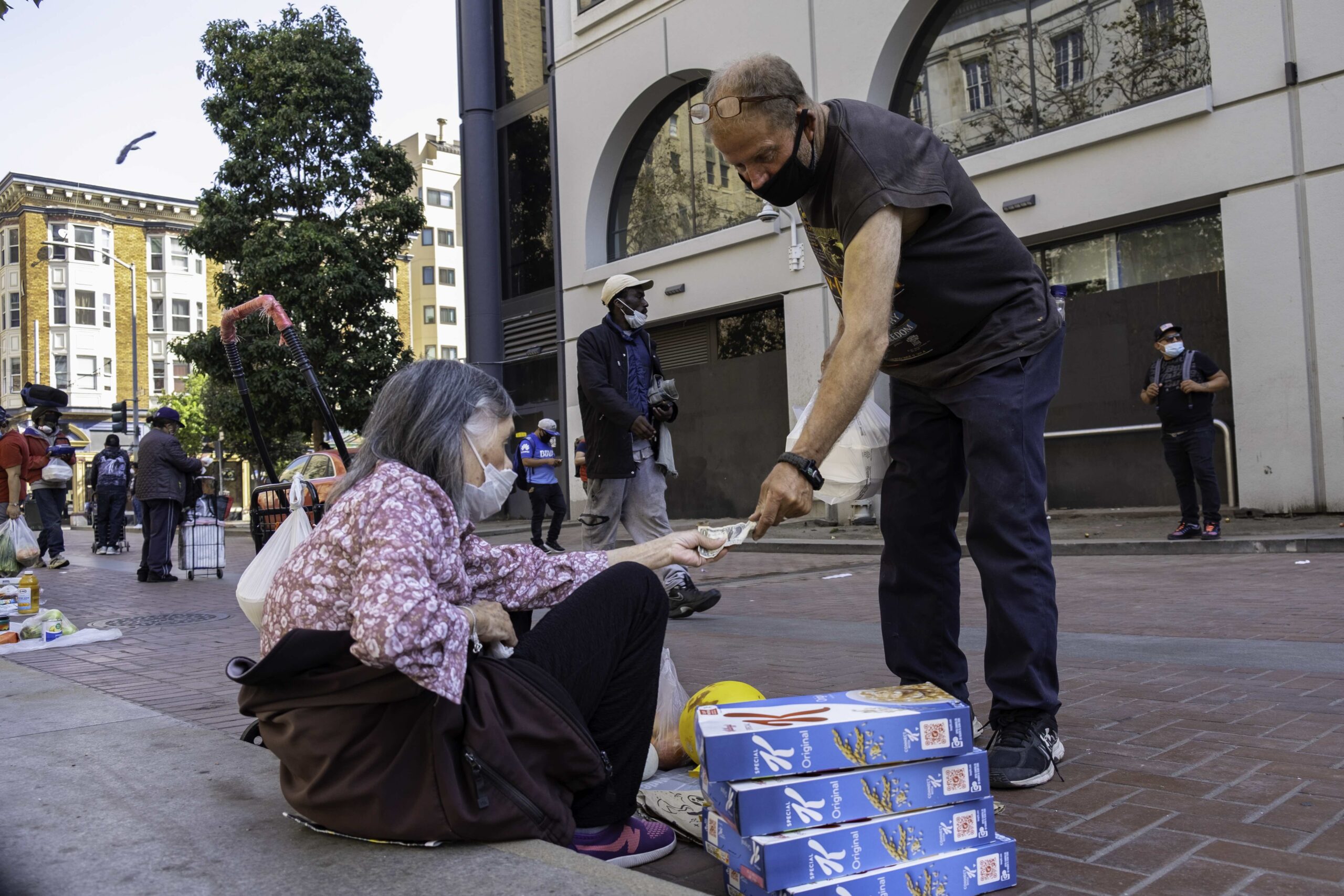
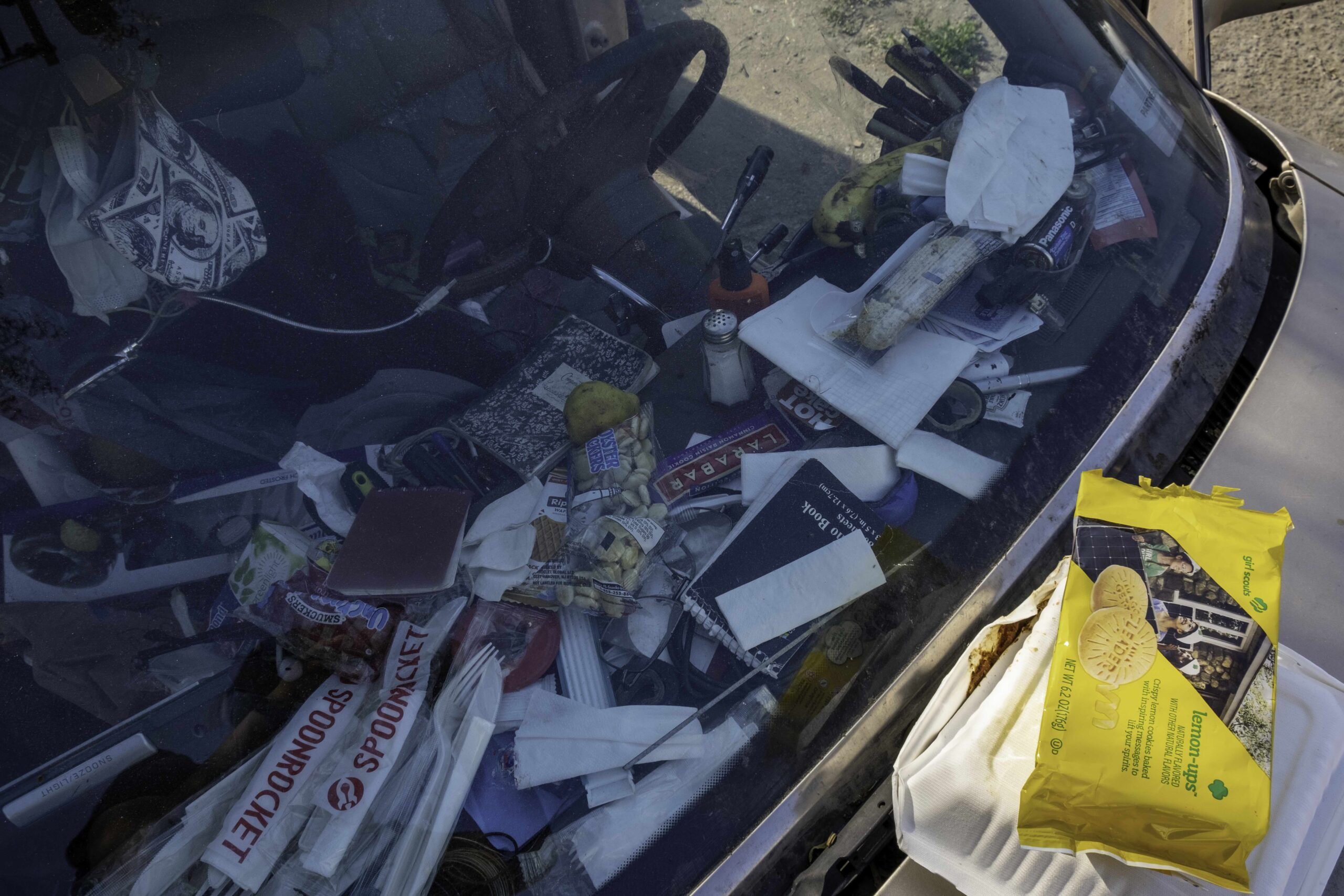

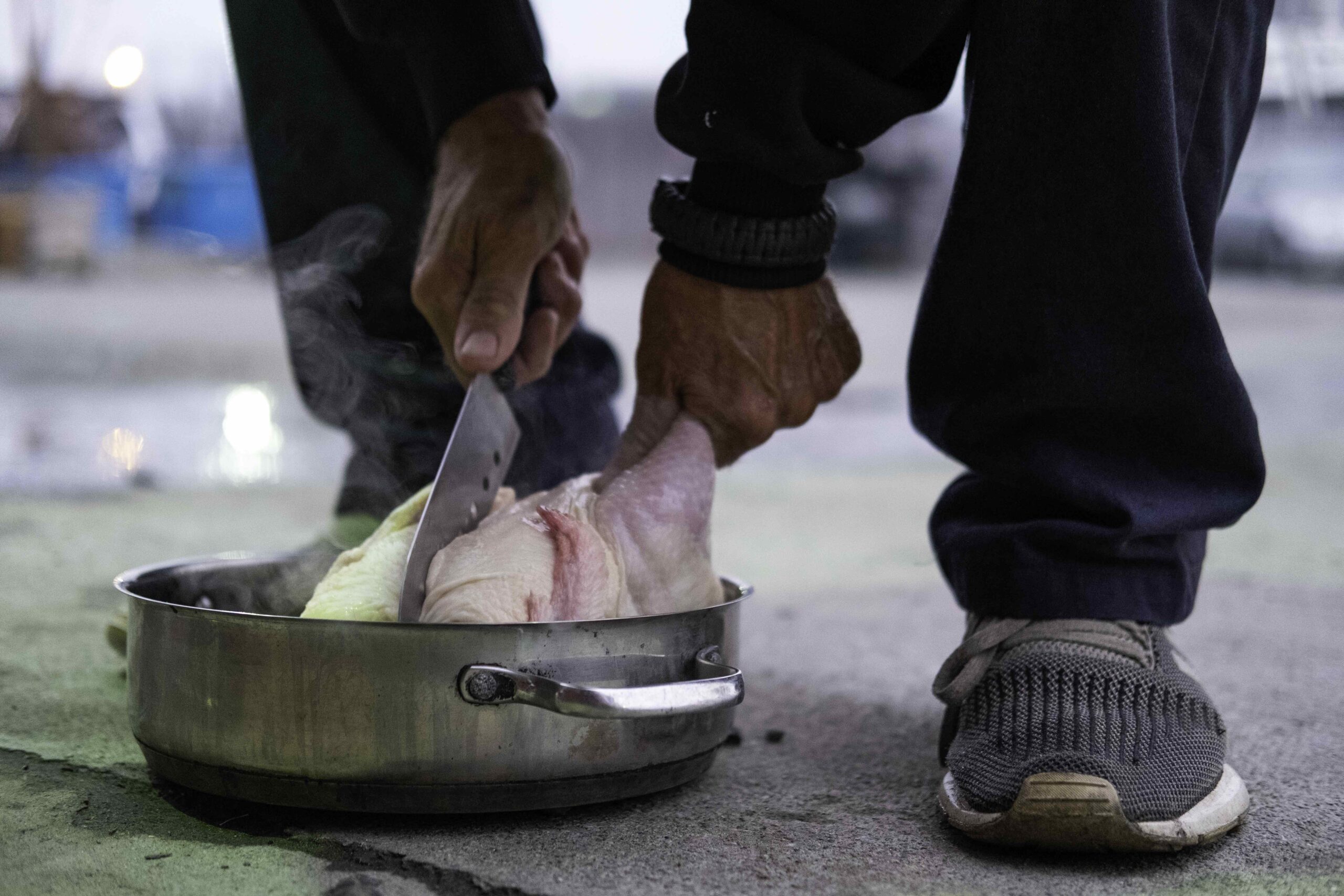
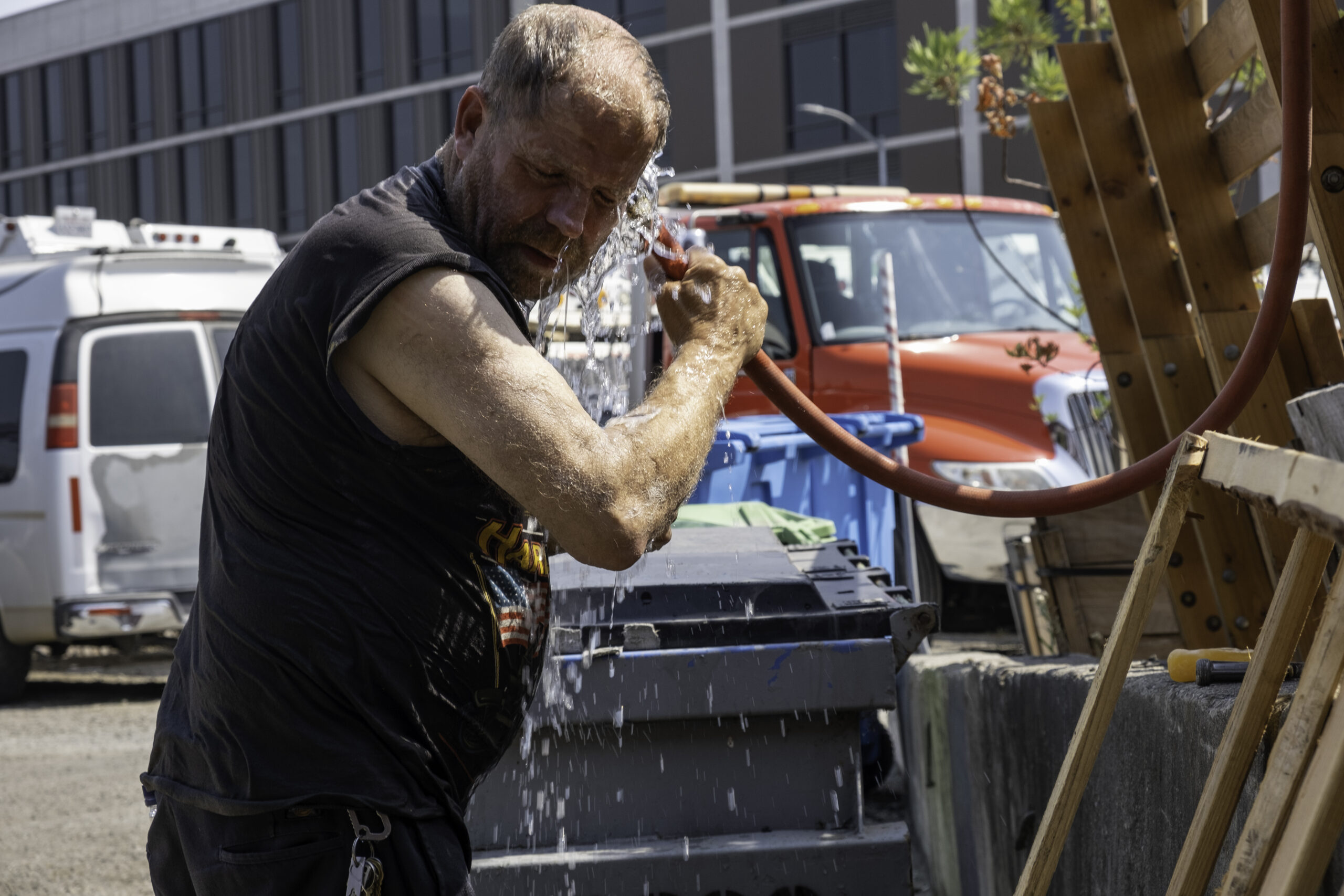
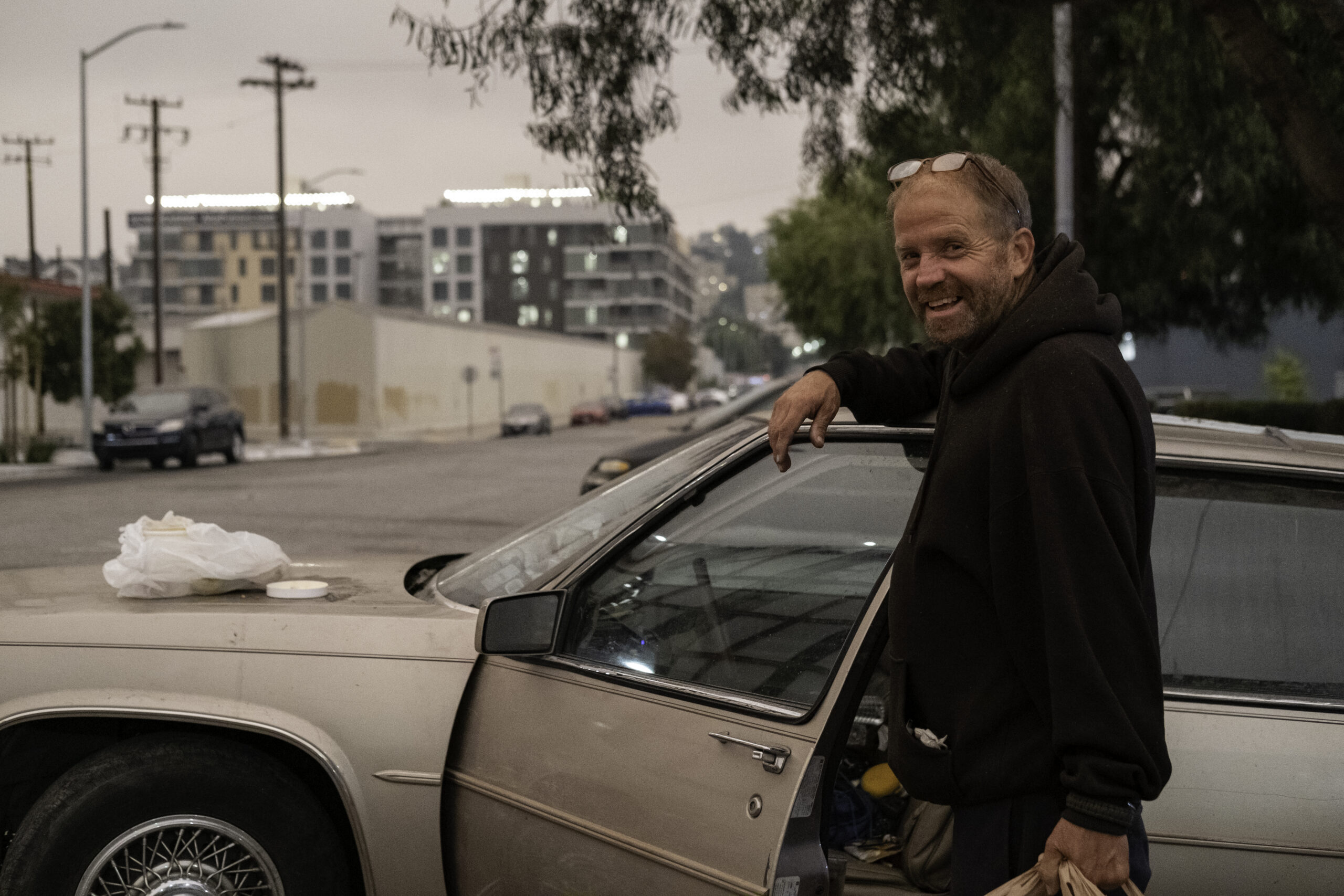

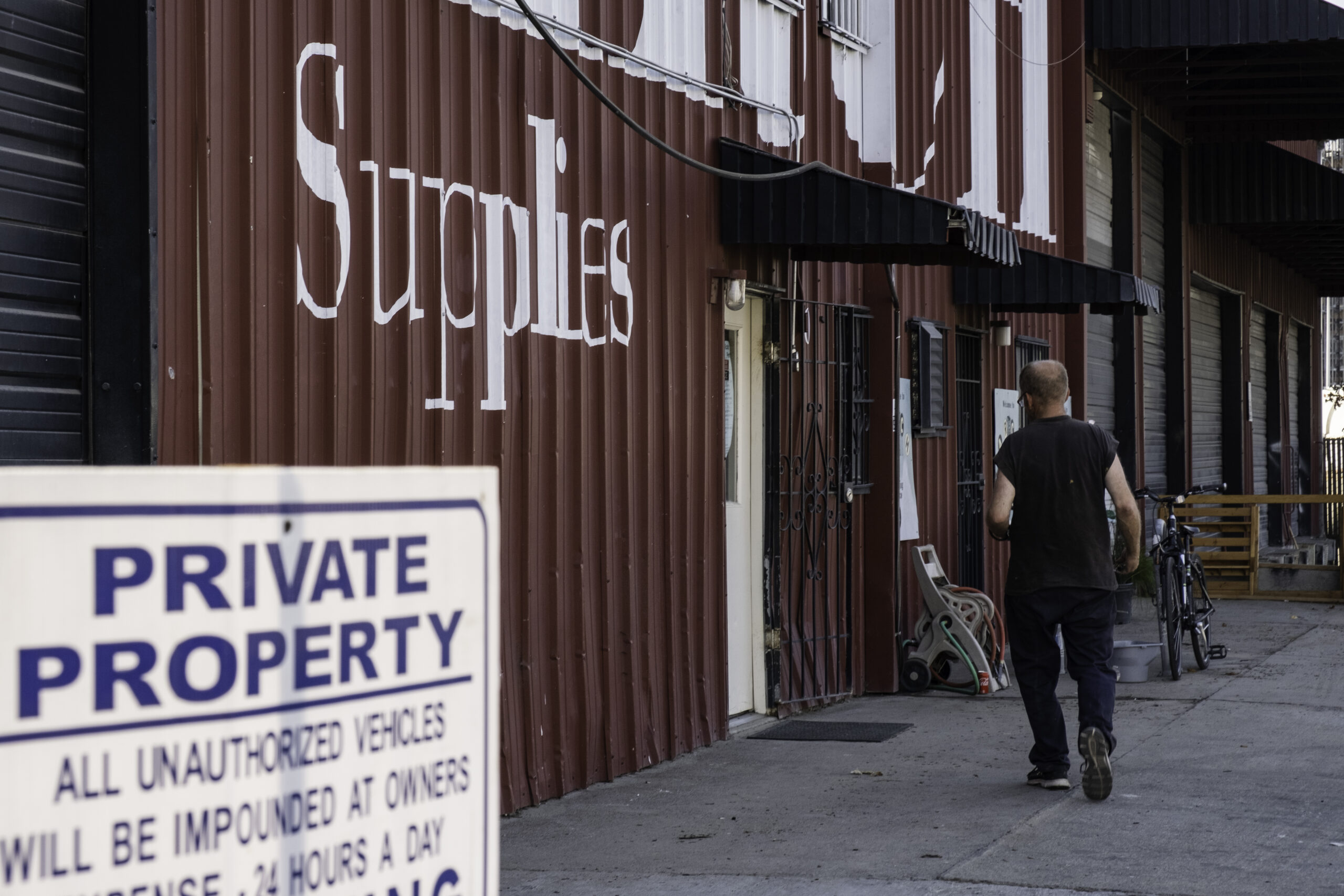
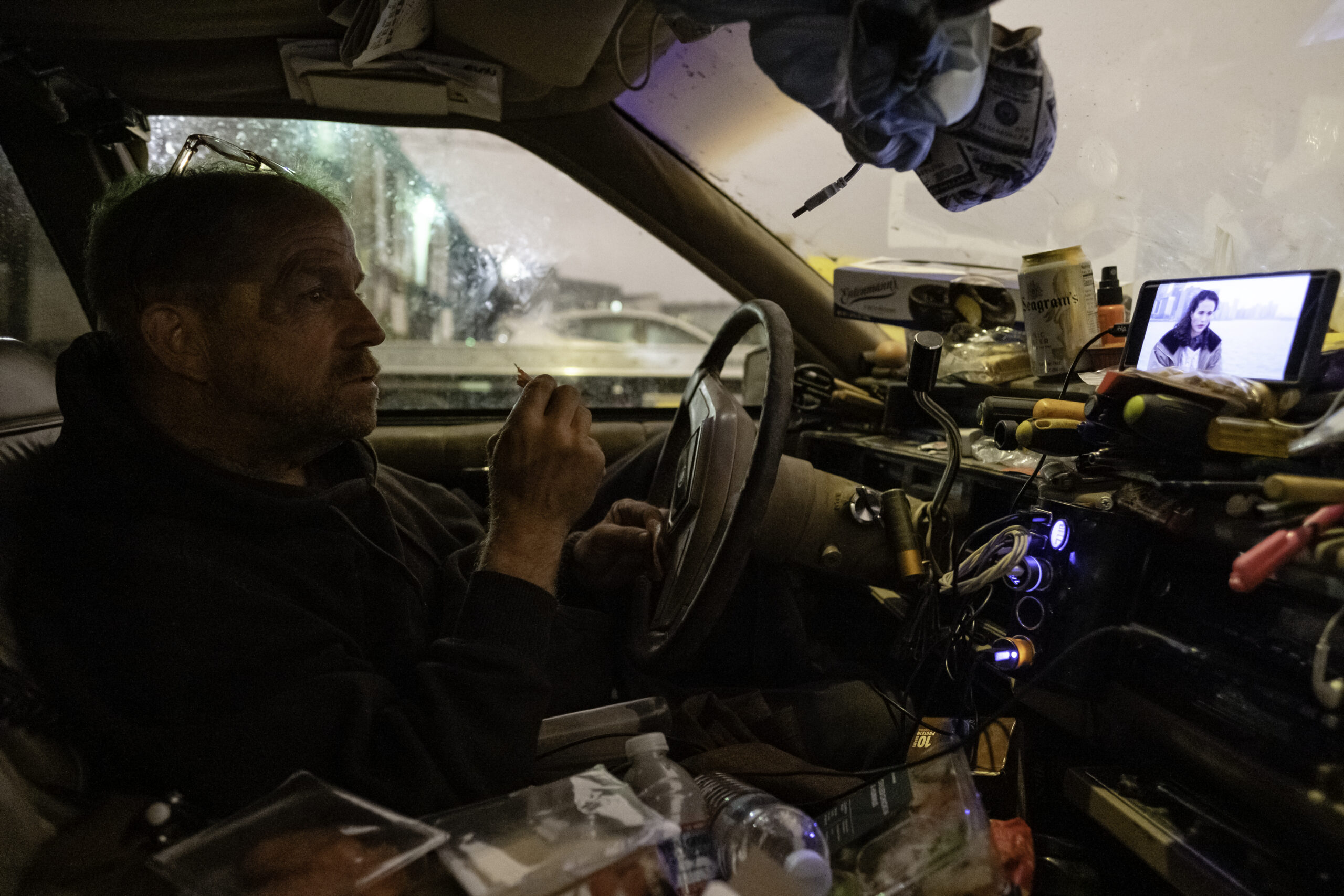

Explore images by clicking through the viewer above, or see the entire photo essay here on a single page.
Sitting up in the leather driver’s seat, Gregory Nelson, 61, is sleeping. Glasses off. Coat on. USB lights off. Vigilance — always on. Warm golden sunlight bathes the tow yard where he parks his 1986 Cadillac — his home — while college students, employees and customers from the Arch art supply store begin parking in the nearby lot on the edge of San Francisco’s Potrero Hill and Mission Bay neighborhoods.
The sounds of car engines and tires on the road are Nelson’s morning wake-up call. This is an improvement from the heavy machinery that construction workers used across the street for months. This fall, construction was completed on the California College of the Arts dormitories, and now, he gets a little more sleep. “The best time to sleep is between 4 to 8 in the morning,” he said.
Through a foggy windshield, Nelson can make out a figure in the distance — a tow truck driver warming up his truck. “And then Dan, the security guy from College of the Arts will stop by every morning around 8:30. ‘He goes, Hey, how are you?’” Nelson said.
He walks with Dan for an hour around campus, before making a three-mile roundtrip trek to pick up breakfast at St. Anthony’s Dining Room in San Francisco’s Tenderloin neighborhood. Since mid-March, Nelson has been parking on the curbside next to the tow yard where he used to be employed.
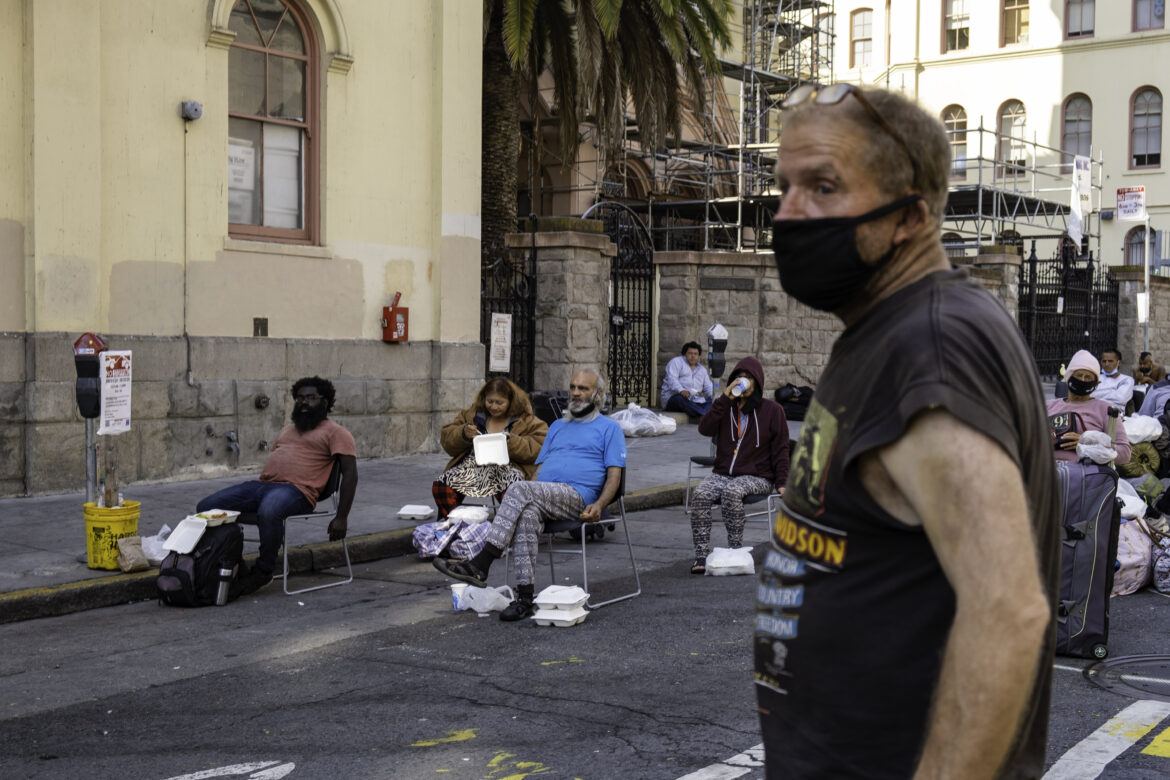
Yesica Prado / San Francisco Public Press and CatchLight Local
On a Sunday morning, Nelson walks three miles roundtrip between the tow yard where he keeps his car parked and the Tenderloin neighborhood, following a routine that involves picking up his breakfast at St. Anthony’s Dining Room. He passes people who have picked up meals and are eating them while sitting in chairs placed on the street by St. Anthony’s. The chairs are spaced six feet apart for social distancing to mitigate the spread of COVID-19. After the coronavirus pandemic began, service providers applied safety restrictions. No more open showers or restrooms. No more public seating to charge devices. No more dining rooms. Rather than claiming a chair on the street, Nelson prefers bringing his take-out food back to his car, and enjoys it in privacy.During the pandemic, parking enforcement has been lax, and the 72-hour rule that forced him to park in a new spot every few days is suspended. He found peace and stability staying in one spot — his version of sheltering in place — like millions of Americans.
The COVID-19 recession
But working from home was not possible for him. Nelson found himself unemployed.
“My only income at that point was the Lyft, and the pandemic destroyed that option,” Nelson said. He worked as an independent contractor for Lyft, using the company’s Express Drive program, which rents vehicles to drivers. But drivers start earning a wage after they cover the cost of their weekly rental, starting at $184 plus fees and taxes for 200 personal miles. These personal miles allow a driver to travel while the application is off. If a driver exceeds their personal mileage plan, Lyft charges them $25 for every extra 50 miles they put on the car.
In March, San Francisco enacted a shelter-in-place order, and residents were told to stay at home and restrict travel to only essential activities like grocery shopping and medical necessities. For the eight weeks that followed, streets were virtually empty — only unsheltered residents remained outdoors, and their belongings continued to be confiscated. Many public spaces were closed. Events were canceled. Students and people whose jobs could be done remotely were told to work from home. And many of those who could not work from home lost their jobs.
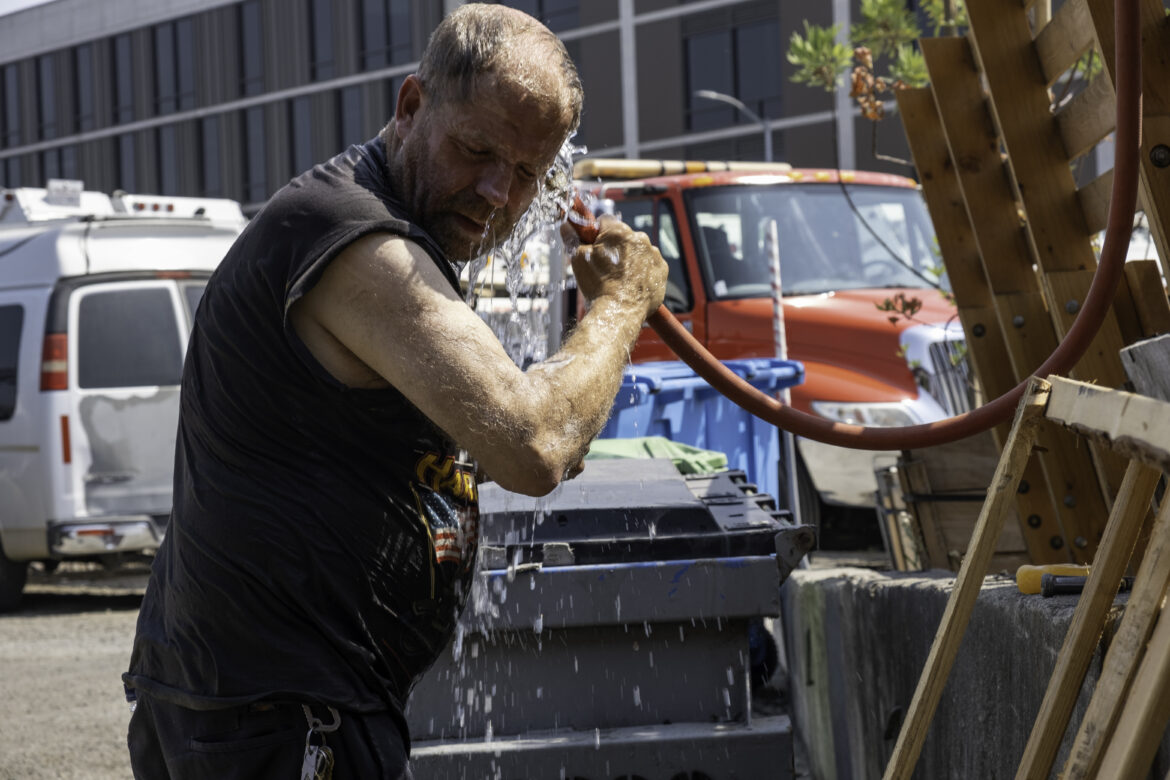
Yesica Prado / San Francisco Public Press and CatchLight Local
On a hot Sunday afternoon in late September, Nelson takes a cold shower using a hose at the tow yard. For Nelson, finding a shower is a daily puzzle. Some homeless service providers have reduced their operation hours, and others temporarily closed their shower services. No public gym showers. Nowhere to go. Nelson quickly bathes with his clothes on to prevent being spotted by passersby. He uses a bar of soap and air dries his clothes while wearing them. It’s too cold to shower with the hose at night, so he maintains his hygiene when no one is looking.In April, the U.S. unemployment rate reached 14.7% — much higher than during the Great Recession in 2009 when unemployment reached 10%. Across the country, 43 states hit their highest unemployment rates since 1976, when the U.S. Bureau of Labor Statistics began tracking annual state unemployment data.
In San Francisco, the unemployment rate reached 13.2% in April. While unemployment has decreased since then, the city has not fully recovered. The unemployment rate was 8.6% in October compared with 1.9% the same month last year — with significant job losses in the leisure and hospitality sector (down 56,100 jobs), which includes jobs in the arts, entertainment, recreation, accommodation and food services. The trade, transportation and utility sector also lost 15,200 jobs.
As the streets became quiet, ride-hailing companies Lyft and Uber both reported that ridership was down more than 60 percent.
Every week he tried to drive for Lyft, Nelson grappled with out-of-pocket expenses to use the ride-hailing app: car rental fees, tolls, gas and the occasional car wash. Within weeks of the shelter-in-place order, Nelson could no longer afford driving.
“I would sit for hours and only get a few rides. A ride per hour,” Nelson said. “And many times, people don’t even tip. I wasn’t making any money. I was just going into debt, so I gave up on the whole thing.”
Surviving the pandemic with social services and mutual aid
Since the pandemic started, more than 57.4 million Americans have filed for unemployment benefits. In late October, 21 million people were still claiming unemployment benefits in all programs. Nationwide, more than half of unemployment claims are a direct result of the pandemic — currently, more than 9.4 million people are receiving Pandemic Unemployment Assistance, and 4.1 million people are receiving Pandemic Emergency Unemployment Compensation benefits.
“I could have applied for some unemployment because I was driving the Lyft, but I’m not greedy like that,” Nelson said. “I’m more self-sufficient. I don’t go around calling broke, even when I am.” And if he needs help, sometimes he’ll ask a friend for $10, he said.
While independent contractors are usually not eligible for unemployment benefits under state requirements, the CARES Act gave governors an option of extending unemployment compensation to independent contractors, self-employed workers and people without sufficient work history to meet qualifications for other programs.
Nelson didn’t pursue this opportunity. Yet, without a steady income, he struggles to find a way to make ends meet, relying on social services and working for his friends.
“I’ll help somebody change a tire, kick me down 10 or 20 bucks,” Nelson said. “I’ll give a jumpstart, or, like the new guy gave me 10 bucks when he got paid. Crazy Javier gives me five bucks because he locks himself out of his car like every other day. He always tells me that he will pay me tomorrow. And I wouldn’t take it, but I need it.”
While Nelson is patient with friends who need favors — as they are with him — he doesn’t have the same patience for bureaucracy. “I called the social services for Cal Fresh, and the guy is asking me questions. My tolerance for jumping through hoops — I’m not tolerant at all,” Nelson said.
Three days later, he got his EBT card in the mail. This card also made him eligible for a lifeline phone. In one stroke, he gained food security and connectivity. “It’s like a domino effect. Uphill dominoes. Because I could not get one service without the other,” he said.
But social services do not pay his bills. Nelson accepted help from friends after losing his gig-economy job. “He reaches into his pocket and he peels off $200 in bills,” Nelson said, recalling his friend Wayne, who lives in a white station wagon, saying to Nelson, “I know you are down on your luck, so here you go.”
Nelson paid for his mailbox through this coming January, which is important to him because it’s the address on his driver’s license — a UPS store in the Mission District. The Department of Motor Vehicles does not allow post office box addresses. But if Nelson does not break this one rule, he risks breaking all of them, a devastating domino effect: No driver’s license? No vehicle registration. No car insurance. And ultimately, the loss of his vehicle home.
Nelson uses the tow yard’s address to access San Francisco and state services. The Daly City address from his former residence, where he last lived with his ex-wife several years ago, is not eligible for Healthy San Francisco.
This year, Wayne also helped pay Nelson’s car registration by giving him a handful of winning scratch-off lottery tickets adding up to $150. “I added up the tickets, I was like, some of them are big. I got enough for my car registration.”
Nelson has also found supportive strangers. “Tessa, the laundromat lady, she ordered my eye vitamins,” Nelson recalled. “I don’t know how many people she buys medication, but for her to take me out of the crowd at the laundromat and be kind to me, it’s really nice.”
Experiencing homelessness, Nelson said, has given him the chance to see good sides of many people, he said. “Being in my position, I feel more gratitude. I feel so humbled, but I really prefer that I wasn’t in a position where I couldn’t say no to the help.”
Daily food challenges
Once a week, Nelson picks up groceries from a pop-up food bank site at Bessie Carmichael Elementary School in San Francisco. The food bank gives away vegetables, fruit and poultry, allowing him to cook his own meals once in a while. Nelson lays out all of his ingredients on his table, the hood of his vehicle, before deciding how he will use them.
“There’s free groceries on Thursday, but they are heavy,” Nelson said. “I try to be considerate of Arch supplies, the customers and students. I have all the stuff — I can cook with propane or run extension cords — but it puts a lot of people off. I try to do that stuff when all the businesses are closed.”
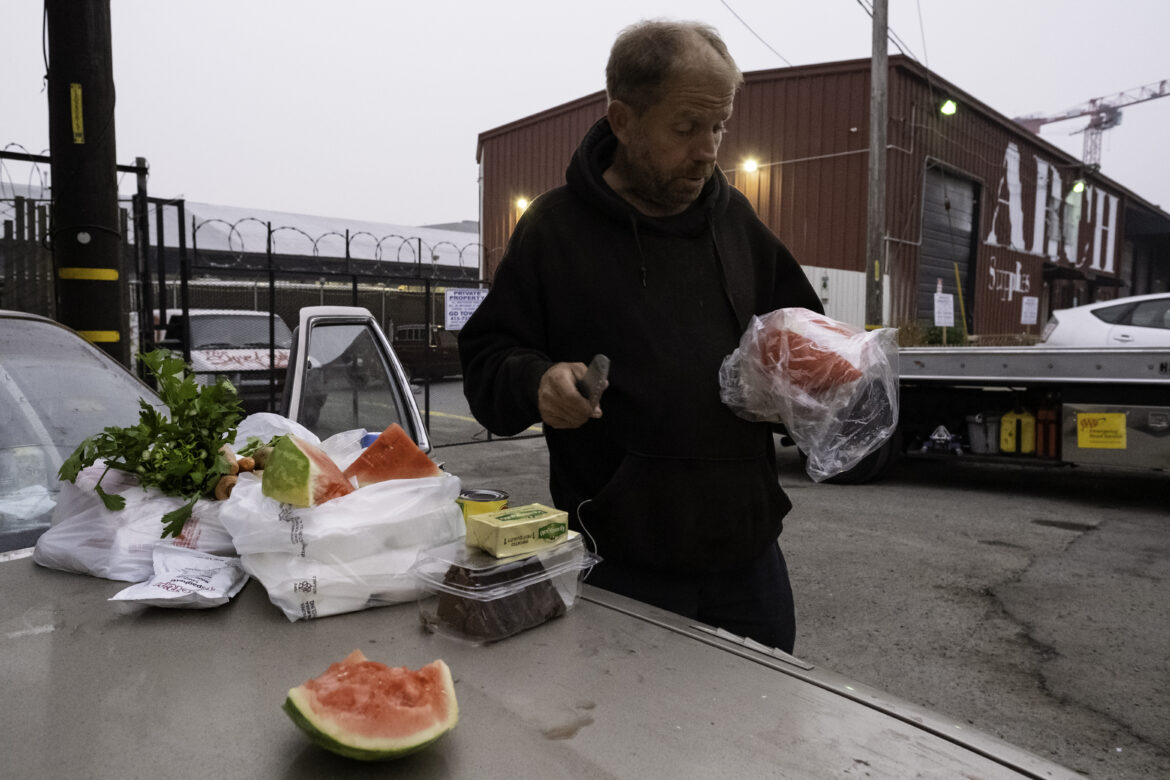
Yesica Prado / San Francisco Public Press and CatchLight Local
Nelson prepares dinner using groceries from a pop-up food bank site at Bessie Carmichael Elementary School in San Francisco. He picks up a weekly supply of groceries like vegetables, fruit and poultry, which allows him to prepare home-cooked meals once in a while. Nelson lays out all of his ingredients on his table, the hood of his vehicle, before deciding how he will use them. Quickly, he decided to cook the chicken, which would spoil if left in his car.Nelson frequents homeless service providers scattered throughout the city, picking up free take-out meals. But walking around town tires him out. “If I’m sore or something is bugging me, then that’s pretty much the end of my day. Or I’ll plan it so I don’t have to go to St. Anthony’s and spend my body on getting on the bus to get things done.”
He saves his CalFresh benefits for emergency use. It’s the “doomsday prepper” in him, he said. He keeps a $600 balance on his card.
“I don’t drain my card. What am I going to buy? I buy snacks,” he said. “I got a gallon of juice and some doughnuts. I’m down for a $30 New York steak in two seconds. But to cook it properly and sit down and enjoy it? It doesn’t work.”
While Nelson cannot cook elaborate meals in his current circumstances, he enjoys small perks. “It’s nice having the food stamp card because I’m used to buying margarine and the cheap stuff,” he said. “But I bought this European butter for $3 and it tastes really good. I was sitting here on my propane stove, frying garlic sausages. I had the fancy butter. I’ll put it in the jar and have nice tasty lard for later.”
An uncertain future
It’s 2 a.m. on a chilly fall night, and Nelson is wide awake. While living at the tow yard has benefits, Nelson often finds himself at odds with other unhoused people looking for places to sleep. He tries to discourage them from encroaching on his territory.
“There’s times where I don’t say a word, I just stand there and stare at them,” he said. “Or I’ve pulled my car out with the headlights on. And no matter which way they go, I just move my car and keep the headlights on. They don’t know what to think. It drives them nuts.”
Most of the time he does not sleep at night. He prepares for the worst, awaiting retaliation.
“This one here is going to go around the corner, hating on me,” Nelson said. “You know, and come back to throw a rock at me or light my car on fire or something like that.”
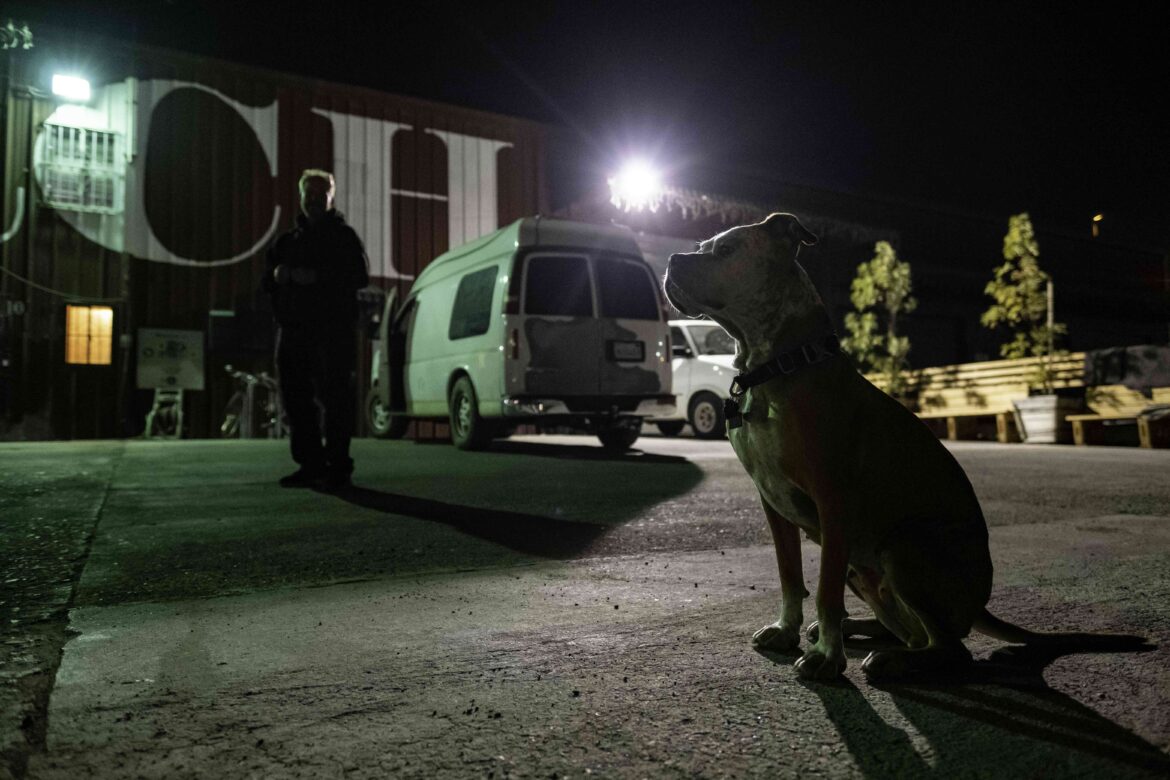
Yesica Prado / San Francisco Public Press and CatchLight Local
April, the tow yard guard dog, perks up her ears at the sound of nearby footsteps on Carolina Street. Nelson laughs at her sudden guard stance and how her bottom never touches the ground. During the pandemic, he gets to enjoy more of April’s companionship, spending most of his days parked down the street from the tow yard lot. Together, they watch over the premises and discourage people from trying to camp there or scan the tow yard’s vehicles for valuables. Every day, Nelson escorts someone off the lot. “April is my only girl,” Nelson said jokingly. “The only one that can stand me and follow me around. Everyone loves her, here. She knows this is her home.”Although police patrol the neighborhood at night, officers have not questioned him about sleeping in his vehicle, he said. But in September, he was issued a street cleaning ticket that he was able to dispute. He was lucky. One less bill to pay. Every dollar counts, especially now that he has chronic pain and has developed some vision problems. He is waiting for approval on his disability claim, which he filed in October.
“My life is so stuck not having nowhere to live. Eventually, I know I will get a check, and then in June, I will get my social security benefits,” when he turns 62, he said. “Worst case scenario, I’m waiting for eight months to get my retirement check.”
Nelson doesn’t have plans to rent a room or find a job, but he hopes he can pay a lot of people back soon, he said. “As far as work goes, I have nothing. If someone wants to pay me to put on a uniform, I would be a security guard,” Nelson said. “My working life is pretty much over. It’s the limitations of my body. If I power myself with ibuprofen, then I can do it for the day. But the next two days, I can’t do nothing.”
Nelson remains optimistic and focuses on the things he values most — his friends and his home — while he waits for a response to his disability claim.
“I’m sleeping in a Cadillac, I can at least brag about that,” he said smiling. “So, I got my pride. I’m not sleeping in no damn Camry.”
This story is part of “Driving Home: Surviving the Housing Crisis” and was produced in collaboration with the Bay Area visual storytelling nonprofit CatchLight through its CatchLight Local Initiative. As a CatchLight Local Fellow at the San Francisco Public Press, Yesica Prado examined the culture of vehicle living in San Francisco and Berkeley. Her fellowship work has been featured by the Yerba Buena Center for the Arts and by the Artists Against an #Infodemic Campaign, which aims to improve access to locally relevant public health information. The CatchLight Local Initiative is funded by the Kresge Foundation, The GroundTruth Project, the Facebook Journalism Project, the Neda Nobari Foundation and the Lisa Stone Pritzker Family Foundation.
